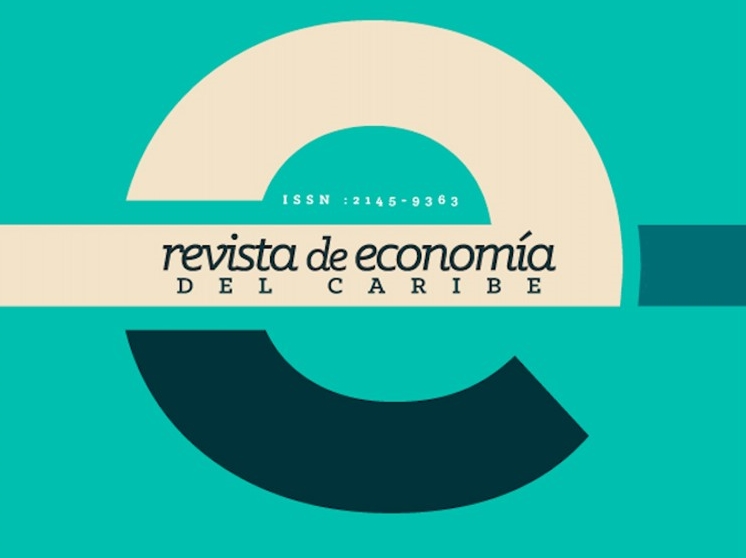Consumption, emigration and remittances: a causal relationship? The Colombian case in the 2005-2022 period.
Keywords:
remesas, consumo final de los hogares, función consumo, vectores autorregresivosAbstract
In this paper, using a VECM Error Correction Model, the relationship between emigration, remittances, real exchange rate and household final consumption for the period 2005-2022 is studied. The analysis is supported by the Keynesian consumption function, which establishes the dependence of consumption on income. Other variables such as the real exchange rate index, Colombian emigration, which according to the perception establishes a Granger causality relationship with remittances, are included. Now, as remittances have increased, they have become part of the permanent income of recipient families, which establishes a relationship between consumption and remittances, so it would be expected that emigration affects consumption. The results found indicate that the elasticity of consumption with respect to remittances is very low, and that it is much higher with respect to percentage changes in the emigration of Colombians. Similarly, it has been found that there is a Granger causal relationship between emigration and final household consumption, and between emigration and remittances.
References
Acosta, P., Fajnzylber, P., & López, H. (2007). The Impact of Remittances on Poverty and human capital: Evidence from Latin American Household Surveys. World Bank Policy Research. https://documents1.worldbank.org/curated/en/446091468046772511/pdf/wps4247.pdf
Amuedo, C., & Pozo, S. (2010). Accounting for Remittance and Migration Effects on Children's Schooling. INSIDE. https://www.sciencedirect.com/science/article/abs/pii/S0305750X10001270
Banco de México. (2022). Remesas y su efecto sobre el consumo de los hogares en las regiones de México en el contexto de la pandemia del covid 19. México: Banco de México. https://www.banxico.org.mx/publicaciones-y-prensa/reportes-sobre-las-economias-regionales/recuadros/%7B1D16C149-35FB-577B-4262-27DB722C71E8%7D.pdf
Banco de la República Colombia. (BR, s.f.). Banco de la República. https://www.banrep.gov.co/es/glosario/remesas#:~:text=Las%20remesas%20comprenden%20las%20transferencias,Balanza%20de%20Pagos%20de%20Colombia.
Bonilla M, L. (2016). Choques externos y remesas internacionales en las regiones de Colombia. Borradores de economía. https://www.banrep.gov.co/sites/default/files/publicaciones/archivos/dtser_250.pdf
Boutania, I., & Kawkaba, S. (2023). The impact of Remittances on household consumption: evidence from Morocco. https://hal.science/hal-04270192/document
Cadena, X., & Cárdenas, M. (2004). Las remesas en Colombia: costos de transacción y lavado de dinero. Revista Coyuntura Fedesarrollo. https://www.repository.fedesarrollo.org.co/bitstream/handle/11445/814/WP_2004_No_26.pdf?sequence=1&isAllowed=y
Centro de Estudios Monetarios Latinoamericanos CEMLA. (2007). Remesas internacionales en Colombia. https://www.banrep.gov.co/sites/default/files/sala_prensa/comunicados/adjuntos/DDP-Colombia_23may07.pdf
Dhakal., S & Oli, S. (2020) The Impact of Remittance on Consumption and Investment: A Case of Province Five of Nepal. https://www.nepjol.info/index.php/qjmss/article/view/29018
Departamento Administrativo Nacional de Estadística DANE. (2022). Sistema de Información de Estadísticas de Migración. https://www.dane.gov.co/files/investigaciones/poblacion/migracion/documento-SIEM.pdf
Garavito, A., Collazos, M., Hernández, M., & Montes, E. (2019). Migración internacional y determinantes de las remesas de los trabajadores en Colombia. Borradores de economía. https://repositorio.banrep.gov.co/handle/20.500.12134/9654
Giuliano, P., & Ruiz-Arranz, M. (2005). Remittances, Financial Development, and Growth. IFM working paper. https://www.imf.org/external/pubs/ft/wp/2005/wp05234.pdf
Gray, J., & Rodríguez, A. (2005). Estudio sobre Migración Internacional y Remesas en Colombia. Bogotá. https://publications.iom.int/system/files/pdf/estudio_sobre_migracion2.pdf
Izaguirre, M., González, A., Font, J., Cases, J., & Arenal, C. (2016). Remesas e inclusión financiera: análisis de la encuesta de migrantes de América Latina y el Caribe en España. FOMIN. https://publications.iadb.org/es/remesas-e-inclusion-financiera-analisis-de-una-encuesta-de-migrantes-de-america-latina-y-el-caribe
Khudor-Castéras, D. (2007). Migraciones internacionales y desarrollo: el impacto económico de las remesas en Colombia. Revista de la Cepal. https://core.ac.uk/download/pdf/38673673.pdf
Kireyev., A. (2006). The Macroeconomics of Remittances: The Case of Tajikistan. IFM Workig paper. https://www.imf.org/external/pubs/ft/wp/2006/wp0602.pdf
Lamsal., R. (2024). The Impact of Workers’ Remittances on Household Consumption Expenditure in Nepal: A Time Series Analysis. In Nepalese Journal of Management Science and Research. https://www.nepjol.info/index.php/njmsr/article/view/64606
Lubambu., K. (2014) The impacts of remmitance on developing countries. https://www.europarl.europa.eu/RegData/etudes/etudes/join/2014/433786/EXPO-DEVE_ET(2014)433786_EN.pdf
Medina, C., & Cardona, L. (2010). The efects of Remittences on Household Consumption, Education Attendance and Living Standards: the Case of Colombia. https://www.redalyc.org/pdf/1552/155216291002.pdf
Mendoza G, M. A. (2021). Las remesas en el contexto de los determinantes del consumo privado en México, 1995-2019. Economía Teoría y Práctica, 29(55), 87-108. https://www.scielo.org.mx/pdf/etp/n55/2448-7481-etp-55-87.pdf
Montenegro, A. (2011). Análisis de series de tiempo. Editorial Javeriana. Bogotá. D.C.
OIM. (2023). World Migration Report 2022. https://worldmigrationreport.iom.int/wmr-2022-interactive/
Ratha, D. (2003), "Workers’ Remittances: An Important and Stable Source of External Development Finance". Workersâ•Ž Remittances: An Important and Stable Source of External Development Finance
Sushanta K. Mallick, S & Mohsin, M. (2016) Macroeconomic Effects of Inflationary Shocks with Durable and Non-Durable Consumption. https:/ideas.repec.org/a/kap/openec/v27y2016i5d10.1007_s11079-016-9405-0.html
Mallik, H (2008). ¿Do remittances impact the economy? some empirical evidences from a developing economy. https://core.ac.uk/download/pdf/19918835.pdf
Solimano, A (2003), "Workers Remittances to the Andean Region: Mechanisms, Costs and Development Impact". https://publications.iadb.org/en/workers-remittances-andean-region-mechanisms-costs-and-development-impact
World Bank. (2022). Remittances brave global headwinds. Migration and Development(37). https://reliefweb.int/report/world/migration-and-development-brief-37-remittances-brave-global-headwinds-special-focus-climate-migration-november-2022-enarruzh?gad_source=1&gclid=EAIaIQobChMIr_f8k6XQggMVPzXUAR3U6gBFEAAYASAAEgKCavD_BwE
Published
Issue
Section
License
I, ____________________________________________, author of the work and/ or article, adult, residing in the city of _________________, bearing the Identity Card/Passport n.° ______________________, issued in _______________________, in command of his/her/their physical and mental faculties, party hereinafter referred to as AUTHOR, signs the following authorization so the reproduction, publication, communication and distribution of the work can be done, under the following terms:
1. That, regardless of existing legal regulations due to the relationship of the parties to this contract, and any other existing legal presumption, the parties agree that the AUTHOR authorizes the Universidad del Norte, with the purpose of reproduce, publish, communicate and distribute the material called in the Revista de Economía del Caribe.
2. That such authorization apply to the copyright of the work, by any means, known or to be known, the public communication of the work, and the distribution of the work, directly or by third parties, purely educational purposes.
3. The AUTHOR undertakes to inform and declare the existence of this authorization and to preserve the right of the journal Revista de Economía del Caribe to the first publication of the work.
4. The AUTHOR states that the article is original and his/her/their exclusive creation, there being no impediment of any kind for the authorization he/she/they is/are giving, responding thereto by any action: claim, plagiarism or any other type of complaint that might arise about.
5. That such authorization is granted for free.
6. The moral rights of the author on the article correspond exclusively to the AUTHOR, in virtue of which, the Universidad del Norte agrees to expressly and rigorously recognize and respect them.





























